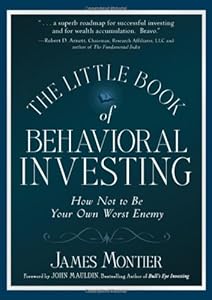Why promising to be good just isn’t good enough…
This is the close of the The Little Book of Behavioral Investing. I must admit that while I expected the review to be an edifying experience, I didn’t expect it to be such fun. Many thanks to James Montier for making what could have been dreary an engaging, relevant and enriching read.
The book is on its last page but what about you and me? It’s certainly not the end for us, it’s a beginning of our journey to becoming better investors.
And why only investors?
Like I mentioned before, the teachings in this book go far beyond the circle of investors. The wisdom is universal as are the traits that make us a victim of our own biases. And the secret sauce here, as Kung Fu panda realized, is that there’s no secret sauce. The only weapon to defeat all biases is you. Through this book, we can learn the tools and strategy to achieve bias nirvana.
But promising to improve won’t do the magic. In fact, there is no magic, just commitment, perseverance and focus.
Montier admits he’s as bad as the rest. He may keep an investment diary and stick to an investment plan but he’s vulnerable when it comes to his eating habits. If eating is his nemesis, change aversion is mine. And though I realize this trait could hurt me in the long run, I don’t do much about it.
Access to knowledge certainly doesn’t guarantee obeisance.
There are some habits we just don’t want to change. It’s too much trouble or maybe, the outcome of harbouring this habit hasn’t hit us yet. Remember “after loss” versus the “risk of incurring a loss” behaviour?
Till the worst hasn’t happened, we don’t push ourselves to change. Montier observes that this happens even when a negligence is of life-threatening proportions. In a group of men and women who were educated on how a condom could prevent the spread of HIV/AIDS, a good percentage still chose not to use one. It’s their very life they’re risking but for some unfathomable reason, they’re supremely optimistic about their chances.
The traits Montier talks about through the book inflict people across the board. Especially over-optimism and excessive self-confidence. Now, I’m not an early riser. So when I set my alarm for 5.15am, I know there’s a good chance I won’t wake up. I even keep the alarm near me, so it’s easy to switch off without opening my eyes! Yet, over the last month, I did this every night, promising myself tomorrow would be different. Where did my optimism come from? I have no idea.
The only way I managed to break this record was keeping the alarm in the next room so I had to walk 20 feet to switch it off. By which time, I can usually usurp my inner devil and head to the washroom instead of the bed.
What I needed was an actionable step, not just a resolve.
Montier gives us actionable steps to alter our habits too. It’s not easy to change and unadvisable to try and change too much at a time. Our body and mind won’t take it.
So, start easy. Apply some rebiasing and simple rules.
To do this, follow a process. For investors, the investment plan provides the process. It is our strongest weapon against all behavioural pitfalls.
Remember, even the world’s leading investors are prone to weaknesses. That’s why they stay away from stock dashboards and media noise themselves, focusing only on their investment plan and giving the responsibility of execution to others.
So don’t be too hard on yourself. Even the best can go wrong without process. The important thing is to recognize and accept your weaknesses, and take steps to control them. Once you’ve figured that out, you’re on the road to becoming a better investor.
Let this be a new beginning.
Monica Samuel is doing a chapter-wise review of the book: The Little Book of Behavioral Investing: How not to be your worst enemy by James Montier. You can follow the series by following this tag: tlbbinvesting or by subscribing to this rss feed: tlbbifeed









